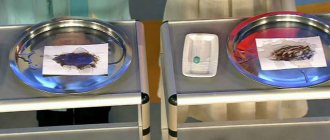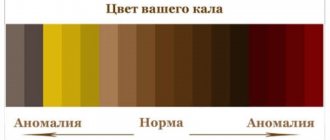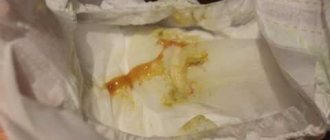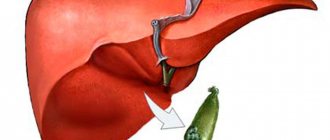Even minimal changes in the child’s condition should concern parents. But you should be especially concerned if there is blood in the baby’s stool. Although there is no guarantee that this phenomenon is associated with danger, it is still important to find out the causes of the blood. In such a case, Komarovsky advises first of all to consult a doctor. But still, every parent should know the reasons why blood appears in the stool.
When blood becomes noticeable in a child’s stool, Komarovsky advises looking for reasons depending on the age of the baby. The fact is that the nature of bleeding in such situations varies very seriously. The source of blood in the stool can vary. This is usually either the stomach or lower intestine. However, “blood” in stool is not always exactly blood. Komarovsky says that quite often parents confuse it with pigments that color waste products in a reddish tint. And before understanding the reasons, you should first rule out the error.
Foods or medications can color stool. Substances and foods that can cause coloration in a child's stool are listed below.
- Antibiotics, medications with dyes and activated carbon.
- Beets and foods with a lot of iron.
- Red gelatin found in many sweets.
- Colorants present in juices and carbonated drinks.
- Chocolate with artificial additives.
If the child consumed one of the following shortly before detecting “blood” in the stool, there should be no cause for concern. But it is not always possible to find the reasons precisely in the wrong diet.
What can blood in a child’s stool indicate?
A child's bloody stool may look different depending on the source of the bleeding:
- Bleeding in the stomach and small intestine, that is, in the upper part of the digestive tract, is the cause of black, thick stools that resemble tar. Iron, which is contained in hemoglobin in the blood, turns black under the influence of hydrochloric acid in the stomach.
- If the source of bleeding is in the lower gastrointestinal tract - the large intestine, rectum or anus, then the blood will be dark red to scarlet.
The cause of rectal bleeding may depend on the baby's age:
- If the child is under one year old, then bloody stool may indicate an allergy to cow's milk protein. It can occur in both breastfed and bottle-fed babies. As a rule, with ABCM, blood in the stool is not the only symptom; the baby may be bothered by abdominal pain (infantile colic), regurgitation, diarrhea or constipation. To confirm the diagnosis, a nursing mother is recommended to go on a dairy-free diet for two weeks and observe whether the baby’s condition improves. In the case of artificial feeding, a mixture with split protein - hydrolyzate - can help; it should also be prescribed by a pediatrician.
- In a child two years old or older, blood in the stool may be the result of juvenile polyps - neoplasms in the intestines. After examination, surgery may be required to remove them.
- Other causes of rectal bleeding - both hidden blood in the stool and fresh scarlet specks - can be equally likely to occur in a child at one month, one year, or two years. These are anal fissures, as well as inflammatory and infectious bowel diseases, helminthic infestations, and intestinal obstruction.
It is important!
Your baby's stool may be colored by food or medications. Dark stools do not indicate bleeding if the child ate beets, chocolate, or other foods with dyes, took antibiotics, iron supplements, or activated charcoal.
Hidden blood in the feces of a baby: causes and tests
Often, your child's pediatrician may ask you to collect stool samples for medical testing. What does hidden blood in a baby’s stool mean - when is it normal, and when does it indicate pathology? Polina Aleksandrovna Kizino, a pediatrician and consultant of the SMART-MOMA project, explains.
— Polina Aleksandrovna, how common is hidden blood in the stool of an infant?
— Blood in a baby’s stool is a fairly rare occurrence. Its appearance can be caused by various reasons, and they are not always due to the condition of the gastrointestinal tract.
Hidden blood in a child’s stool: causes:
- Intestinal polyps;
- Ulcerative colitis;
- Bleeding in the gastrointestinal tract;
- Nosebleeds;
- Teething with disruption of the integrity of blood vessels;
- Eating certain foods;
- False positive diagnostic test results.
Blood in the stool does not always indicate problems with the digestive system. Therefore, a stool test for occult blood in an infant (coprogram) will not indicate a specific diagnosis and will not indicate exclusively disturbances in the functioning of the gastrointestinal tract.
— In what situations is it necessary to look at stool for occult blood in a baby?
— The reaction to occult blood in an infant is not screening testing. There really must be serious reasons for this analysis. The examination is carried out to confirm or deny the presence of a disease that damages the intestinal walls, which in turn leads to blood entering the lumen of the gastrointestinal tract. These could be polyps, ulcers, Crohn's disease, ulcerative colitis, cancer - but all of them are more typical for older people.
Indications for examination of a child are anemia in combination with symptoms from the gastrointestinal tract. For example, it may be diarrhea with the following characteristics:
- frequent repetition over several weeks;
- stomach ache;
- violation of the child's condition;
- possible disruption of weight gain and height.
Such signs allow the doctor to suspect a disease that manifests itself as intestinal bleeding and order a laboratory examination. In most cases, if the child feels well and his condition is not impaired, it is unlikely that the doctor will have reason to order a stool occult blood test. This is the diagnostic norm.
Other tests for occult blood
| Benzidine test or Gregersen reaction |
|
| Enzyme immunoassay tests |
|
— Why are some pediatricians convinced that testing for occult blood in feces is useless for a small child?
— This test is rarely prescribed to children, because in childhood the diseases we talked about and which are diagnosed using an occult blood test are much less common. In addition, there is a high risk of a false positive reaction due to nosebleeds, vascular damage during teething and other microbleedings, when blood can enter the gastrointestinal tract and be detected in the stool. But this does not indicate the presence of a dangerous disease.
Diagnostic tests that can replace stool occult blood testing
| Fecal calprotectin test |
|
| Ultrasound of the gastrointestinal tract |
|
| Sigmoidoscopy |
|
| Intestinal biopsy |
|
Blood in an infant's stool often appears due to situations that are not related to the condition of the gastrointestinal tract. And only in a small percentage of cases, unfortunately, children suffer from serious pathologies. Therefore, occult blood testing is rarely performed at an early age.
pediatrician, consultant of the SMART-MOMA project Polina Aleksandrovna Kizino
*The ideal food for an infant is mother's milk. WHO recommends exclusive breastfeeding for the first 6 months. MAMAKO® supports this recommendation. Before introducing new foods into your baby’s diet, consult a specialist.
Are streaks of blood in a child’s stool dangerous?
Blood in a child’s stool can be either a consequence of disorders that are not dangerous to health, or a serious symptom in which it is necessary to exclude acute surgical pathology. Under no circumstances should you make a diagnosis yourself. The reason for the appearance of blood in the stool should be determined by the doctor after examining the baby.
If the blood is not mixed with the stool, looks like a scarlet droplet, or remains only on toilet paper, most likely it came from an anal fissure. This is a relatively harmless symptom and often occurs with constipation.
If streaks of blood appear regularly in the stool, this can be a dangerous condition. It is necessary to find out their cause as soon as possible.
It is important!
If you notice that against the background of the appearance of blood in the stool, the child’s condition has sharply worsened, he has turned pale, has become lethargic, is experiencing abdominal pain, if blood is flowing from the anus, call an ambulance immediately.
Komarovsky about other causes of blood in stool
The reasons presented below are not as common as the two previously described. True, this does not mean that they are less dangerous. Blood in the stool can also be a consequence of such health problems for the child.
- Intestinal inflammation. With ulcerative colitis and other inflammatory bowel diseases, blood in the stool becomes a characteristic manifestation. Reduced appetite and a sharp decrease in body weight are also usually observed.
- Infection, parasites, bacteria in the intestines. Most often, this phenomenon, according to Komarovsky, is observed in schoolchildren and preschoolers. For a similar reason, there is diarrhea, fever, and cutting pain in the abdomen. In this case, it will not be possible to return the child to a normal state without a course of antibiotics.
- Juvenile polyps. Between the ages of two and eight years, a child may develop growths on the surface of the large intestine. Then blood often appears in the stool. Moreover, Komarovsky says that other symptoms usually do not appear. However, a doctor's examination in such a situation is necessary.
- Intestinal obstruction. It usually develops suddenly, so a similar cause cannot be excluded. Obstruction can lead to heavy bleeding, so it is important to immediately contact a specialist.
Any of the reasons presented carries great danger. This means that caring parents should provide their child with complete treatment as soon as possible. Komarovsky emphasizes that the treatment process cannot be delayed. Otherwise, there is a risk of developing extremely undesirable consequences. From this it follows that the doctor must find out the cause of blood in the child’s stool.
Blood in the stool of a child with constipation
Constipation is one of the most likely causes of cracks in the mucous membrane of the rectum and anus, and therefore blood in a child’s stool.
With constipation, stool becomes compacted and accumulates in the rectum. The child makes efforts to get rid of them. The tissues become overstretched and are easily injured by hard feces. A single case of constipation rarely leads to such consequences. In a child who suffers from constipation regularly, the risk of blood in the stool is much higher.
Constipation is painful for the baby in itself, and painful cracks add to the baby’s suffering, so adjust the diet and drinking regime of a child prone to constipation and do not forget to care for the delicate skin around the anus: wash after each bowel movement, if necessary, treat with cream or baby oil.
We draw conclusions:
- Blood in the stool of a baby under one year old may indicate an allergy to cow's milk proteins; in a child over two years old, it most often indicates an anal fissure. Regardless of age, anal fissures due to constipation, inflammatory, infectious, parasitic diseases, and intestinal obstruction are possible.
- In children prone to constipation, anal fissures may appear, since hard feces injure the mucous membrane. From them, droplets of scarlet blood fall onto the feces and toilet paper.
(0 ratings; article rating 0)
Share Share Share
Anal fissures in children
April 30, 2021
One of the most common complaints during an appointment with a pediatric surgeon is the discovery of blood in the stool. Naturally, this frightens parents, but, fortunately, in the vast majority of cases, this is not associated with serious problems in children. Proctological diseases in children are less common than in adults (if we do not consider congenital malformations, which can manifest themselves throughout life).
The appearance of blood in the stool can be observed in some diseases that affect both the anorectal area and the gastrointestinal tract in its various parts. One of the most common problems in pediatric outpatient proctology is anal fissures.
An anal fissure (anal fissure) is a defect in the mucous membrane of the anal canal. For the most part, this pathology occurs in preschool age, equally often in boys and girls.
Causes:
As a rule, the main cause of tearing of the anal canal mucosa is the passage of dense feces. However, there are also predisposing causes - these include diarrhea (diarrhea) of various etiologies, proctitis (inflammation of the rectum) and other conditions that cause swelling of the rectal mucosa, as a result of which its mucosa becomes more vulnerable. Less commonly, scratching caused by itching in the anus due to helminthic infestations, as well as rough mechanical impact (for example, injury from a hard enema tip), can lead to the formation of cracks.
Complaints:
If a child has this disease, parents most often pay attention to two factors: the child’s severe anxiety when trying to defecate, even to the point of refusing to sit on the potty, and secondly, the presence of blood in the stool. An anal fissure is characterized by the presence of scarlet blood at the end of evacuation, or on toilet paper. In children of the first year of life, parents are usually concerned about the presence of blood streaks in the diaper.
Pain with anal fissure is associated with the act of defecation (emptying) and has varying severity and duration. Due to fear of pain, the child suppresses the urge to defecate. Retention of stool leads to compaction of feces, which in turn contributes to greater trauma to the fissure, resulting in a reflex contraction (spasm) of the sphincter. This increases pain and prevents the defect from healing. A vicious circle is created. The child begins to be afraid of the upcoming act of defecation.
Diagnostics:
If blood appears in the stool, an examination by a surgeon is necessary. The examination of the rectum begins with careful separation of the buttocks and examination of the anus. If a disease of the anorectal region is suspected, a digital rectal examination is also necessary.
However, if an anal fissure is obvious, the doctor may postpone the rectal examination until the defect in the anal mucosa has healed, so as not to aggravate the child's pain. However, you need to understand that the presence of an anal fissure cannot exclude the presence of other diseases of the anorectal area, therefore a rectal examination is mandatory, even if the defects are healed and there are no complaints.
Treatment:
Treatment of anal fissures in children is in most cases conservative and is aimed at normalizing stool, relieving pain and sphincter spasm, as well as healing the fissure itself.
First of all, it is necessary to regulate the drinking regime and diet. The volume of fluid consumed should be increased. A diet that includes foods and dishes that enhance motor function and bowel movements (vegetables, fresh and dried fruits, wholemeal baked goods, fermented milk products, etc.) is recommended.
To restore normal bowel function, products made from yeast and puff pastry, soups with first broth, sweet soda, pasta, rice, mushrooms, and legumes should be excluded from the diet. As for drinks, jelly, cocoa, and strong tea should not be allowed on the menu. Among the fruits and berries that are prohibited are bananas, blueberries, and dogwoods; from sweets: chocolate, and desserts with custard. Food is prepared mostly unchopped, boiled in water or steamed, or baked.
To soften stool, Vaseline oil and flax seeds are prescribed internally.
However, in addition to following the food and drinking regime, local treatment is very important - daily cleansing enemas followed by sitz baths with a slightly pink solution of potassium permanganate or chamomile, healing suppositories, and the use of healing ointments are mandatory. Local treatment should be prescribed by a doctor.
The prognosis of this disease in children is usually favorable if the doctor’s recommendations are followed promptly and fully. In exceptional cases, the process may become chronic and require invasive treatment methods, which is usually typical for adolescent children.
It is important for parents to understand that bleeding from the anus can have various causes, not always associated with proctological diseases. That is why you should not self-medicate; you should consult a doctor at the first signs of the disease in order to receive timely recommendations for both examination and treatment.











